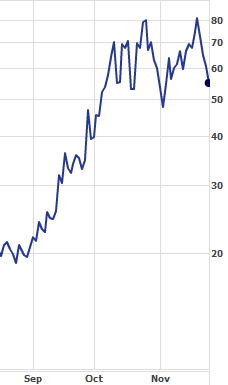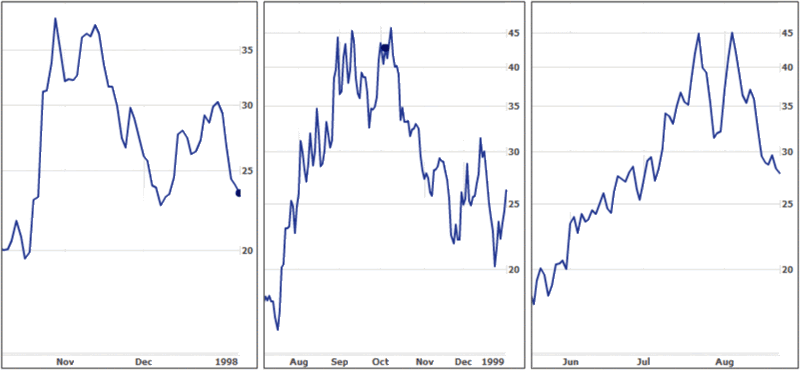The following is adapted from a subscriber newsletter segment that appeared in the November 26th newsletter.
 I have never seen any research on the subject of VIX double tops, but given the recent double top formation in the VIX, I thought this might be a good time to share some of my thinking on the subject. First, the chart at the right shows the recent VIX levels from mid-August to the present. The first spike in the double top comes on October 24th and the most recent spike comes on November 19th.
I have never seen any research on the subject of VIX double tops, but given the recent double top formation in the VIX, I thought this might be a good time to share some of my thinking on the subject. First, the chart at the right shows the recent VIX levels from mid-August to the present. The first spike in the double top comes on October 24th and the most recent spike comes on November 19th.
Double tops are fairly common in the 19 year history of VIX data and frequently coincide with extreme readings in the VIX. By contrast, VIX triple tops are relatively rare; and while single VIX spikes are common in more mundane market conditions, they are less likely to be found at VIX extremes than double tops.
In fact, prior to this year, the three crises with the most extreme VIX readings were the 1997 Asian Financial Crisis, the 1998 Long-Term Capital Management Crisis, and the 2002 bottom of the technology bust that accompanied the WorldCom bankruptcy filing. In the graphs below, I have recorded the history of these VIX spikes. You can clearly see a double top pattern in the VIX in all three instances. Interestingly in each instance, the spikes were separated by approximately 2-3 weeks and signaled major turning points in the markets.
Recent events have shown that extrapolating from past chart patterns to the current market is fraught with danger, but I would argue that the presence of a VIX double top reinforces the case that the recent stock market bottom will prove to be an important market inflection point.

[source: Yahoo, VIX and More]
The weekly and monthly dragonfly dojis that occurred in the SPX 500 index is another bullish sign for the markets. A close above SPX 500 will complete an inverted head-and-shoulders bottom in the SPX 500 index as well. A bullish week for the various major stock market indexes would not be surprising.
ReplyDeleteCorrection to my last posting;
ReplyDeleteThe weekly and monthly dragonfly dojis that occurred in the SPX 500 index is another bullish sign for the markets. A close above 880 in the SPX 500 will complete an inverted head-and-shoulders bottom in the SPX 500 index as well. A bullish week for the various major stock market indexes would not be surprising.
Why are the VIX graphs labeled 1998, 1999, and 2002 if you are plotting events from 1997, 1998, and 2002?
ReplyDeleteRegarding the years in the graphs, that's just how Yahoo chooses to label their charts, with the year essentially taking the place of where the 'January' label would be.
ReplyDeleteGood post! Only problem I have with it though is that I don't believe we've reached the first top yet. Today's TNote was auctioned off at zero percent. That tells me there is still fear out there.
ReplyDelete